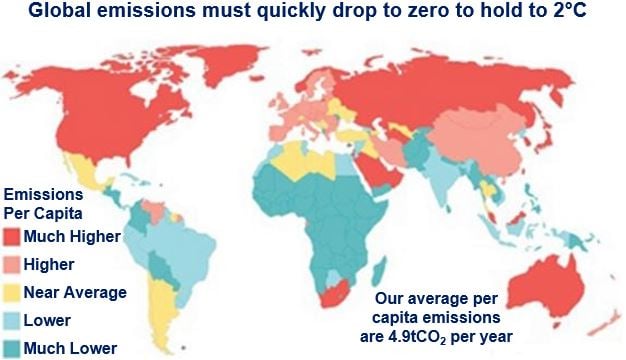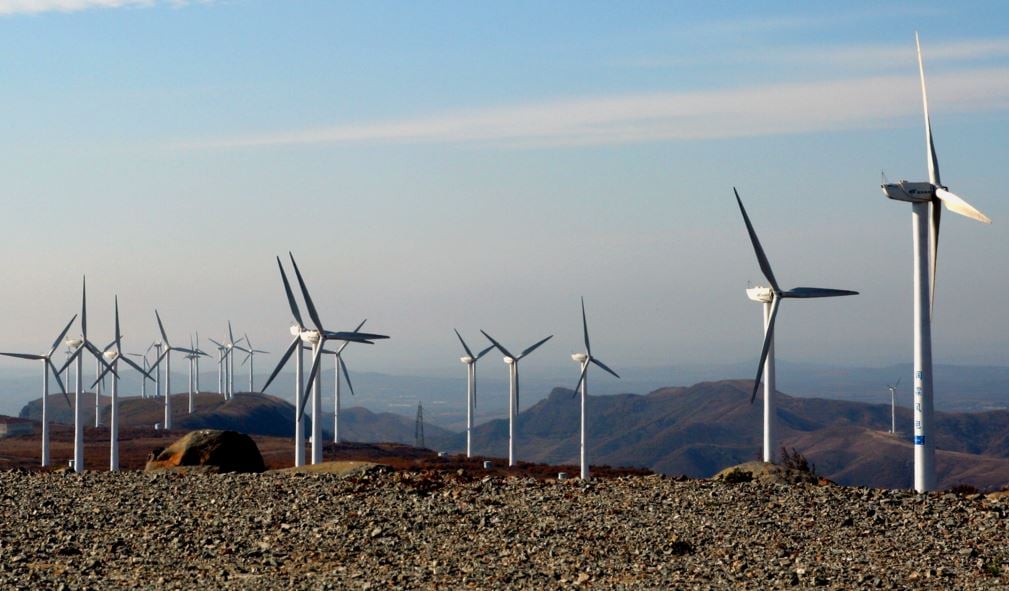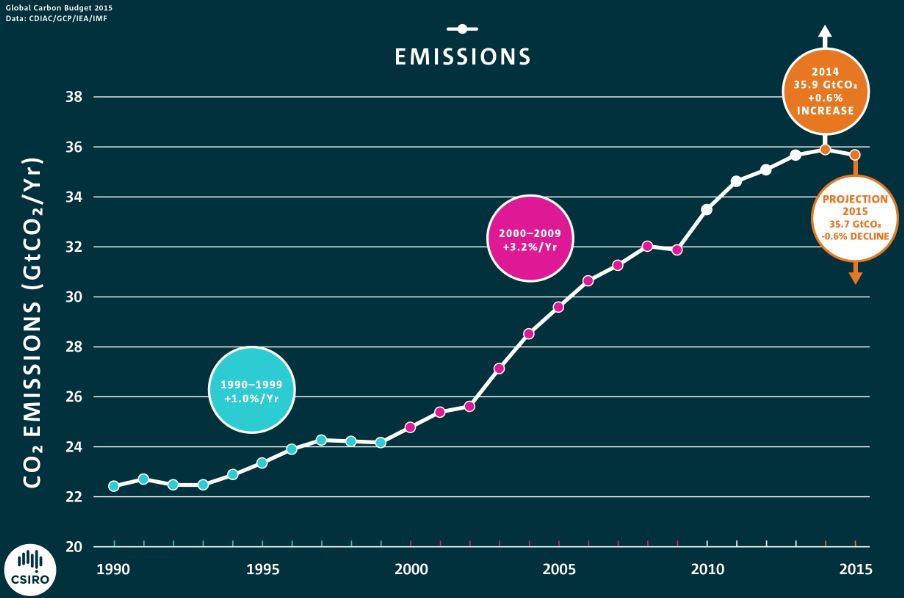Global carbon emissions are forecast to be lower in 2015, the first time this has happened during a period of global GDP growth, after rising by just 0.6% in 2014. Scientists at the University of East Anglia in England and colleagues from the USA, Australia, Norway and Austria, believe we could be at a global emissions turning point in our fight to stem the effects of climate change.
The research team published its findings in the academic journal Nature Climate Change (citation below), and also the journal Earth System Science Data.
The authors wrote that their research showed that emissions are likely to fall by -0.6% in 2015. While lower carbon emissions have been recorded during periods of economic crisis, this will be the first fall when the world’s economy grew strongly.
 Emissions from fossil fuels & industry grew by +0.6% in 2014, and are projected to fall by -0.6% (-1.6 to +0.5) in 2015. (Image: www.uea.ac.uk)
Emissions from fossil fuels & industry grew by +0.6% in 2014, and are projected to fall by -0.6% (-1.6 to +0.5) in 2015. (Image: www.uea.ac.uk)
Emissions appear to have stalled and perhaps declined
Head of data analysis, professor Corinne Le Quéré, who is Director of the University of East Anglia’s Tyndall Centre, said:
“These figures are certainly not typical of the growth trajectory seen since 2000 – where the annual growth in emissions was between 2 and 3 per cent. What we are now seeing is that emissions appear to have stalled, and they could even decline slightly in 2015.”
“But it is important to remember that our projection for 2015 is an estimate and there will always be a range of uncertainty. In this case, the 2015 projection ranges from a global decline in emissions of up to 1.5 per cent – or at the other end of the spectrum, a small rise of 0.5 per cent.”
The 2015 forecast is based on available energy consumption data in the US and China, as well as on predicted GDP (gross domestic product) growth in the rest of the world.
Prof. Le Quéré added:
“The projected decline is largely down to China’s decreased coal use, driven by its economic adjustment. Whether a slower growth in global emissions will be sustained depends on the use of coal in China and elsewhere, and where new energy will come from.”
“In 2014, more than half of new energy needs in China were met from renewable sources such as hydro, nuclear, wind, and solar power.”
 To hold global atmospheric temperature increases to a 2°C maximum is going to be extremely difficult. (Image: www.uea.ac.uk)
To hold global atmospheric temperature increases to a 2°C maximum is going to be extremely difficult. (Image: www.uea.ac.uk)
Most emissions concentrated in four regions
According to the study, the largest contributors to global emissions last year were:
– China: 27%,
– The US: 15%,
– the EU: 10%,
– India: 7%.
Prof. Robert Jackson, from Stanford University, who headed the Nature Climate Change Commentary, said:
“We saw slower global growth in petroleum in 2014 and faster growth in renewables. Wind and solar capacities saw record increases in capacity last year and are on track to be even higher in 2015.”
Prof. Le Quéré commented:
“With two years of untypical emissions growth, it looks like the trajectory of global emissions might have changed temporarily. It is unlikely that emissions have peaked for good. This is because energy needs for growing economies still rely primarily on coal, and emissions decreases in some industrial countries are still modest at best.”
“Global emissions need to decrease to near zero to achieve climate stabilisation. We are still emitting massive amounts of CO2 annually – around 36 billion tonnes from fossil fuels and industry alone. There is a long way to near zero emissions.”
“Today’s news is encouraging, but world leaders at COP21 need to agree on the substantial emission reductions needed to keep warming below two degrees Celsius. And despite the slowing of CO2 emissions globally, the amount of CO2 in the atmosphere has now reached 400 parts per million, its highest level in at least 800,000 years.”
 Today, China is the world’s largest wind-energy producer. (Image: globalcarbonproject.org)
Today, China is the world’s largest wind-energy producer. (Image: globalcarbonproject.org)
Headline Stats by Country for 2014
China: was the largest CO2 emitter, releasing 9.7 billion tons, or 27% of the world’s total. Whatever is emitted from China will significantly influence the world total over the next decade.
After increasing by 6.7% annually over the previous decade, China’s CO2 emissions growth slowed right down to 1.2% annually in 2014. A slight decline has been forecast for this year.
The drastic slowdown in 2014 and 2015 is mainly due to decreased coal use. China, which is today the largest wind-energy producer in the world, installed 23 GW of new wind capacity in 2014.
CO2 emissions per capita in China are 7.1 tonnes, which is much lower than 17.4 tonnes in the US and 6.8 tonnes in the EU. India’s per capita emissions stand at 2 tonnes.
United States: released 5.6 billion tonnes or 15% of the world’s total, making it the second largest. Over the past decade, emissions have declined by 1.4%. The country is predicted to register another fall this year.
 Is this the turning point we have all be hoping for? (Image: www.csiro.au)
Is this the turning point we have all be hoping for? (Image: www.csiro.au)
European Union: released 3.4 billion tonnes, or 10% of the world’s total. Over the last ten years, emissions have declined by 2.4% annually. It is the region with the steepest decline in emissions.
The EU’s 2014 decline in emissions of 210 MtCO2 was about the same size as India’s 205 MtCO2 increase.
Initially, outsourcing of emissions to developing nations played a significant role in the EU’s early reductions. Since 2007, however, most of the EU’s decline has come from within the region.
India: released 2.6 billion tonnes or 7.2% of the world’s total, matching those of China in 1990.
India, which struggles to provide enough power for its 1.3 billion citizens, is likely to continue emitting more and will probably match levels currently registered in the EU within the next three years.
The authors wrote:
“For global CO2 emissions to peak and decline quickly, part of India’s new energy needs must come from low-carbon technologies.”
United Kingdom: released 0.43 billion tonnes, or 1.2% of the world’s total. In 2014 emissions declined by 9%, and are today 28% below 1990 levels.
Citation: “Reaching peak emissions,” Robert B. Jackson, Josep G. Canadell, Corinne Le Quéré, Robbie M. Andrew, Jan Ivar Korsbakken, Glen P. Peters & Nebojsa Nakicenovic. Nature Climate Change. 7 December, 2015. DOI: 10.1038/nclimate2892.
Video – Global Carbon Budget 2015
What’s the Global Carbon Budget all about? Watch this Future Earth video to find out more!

